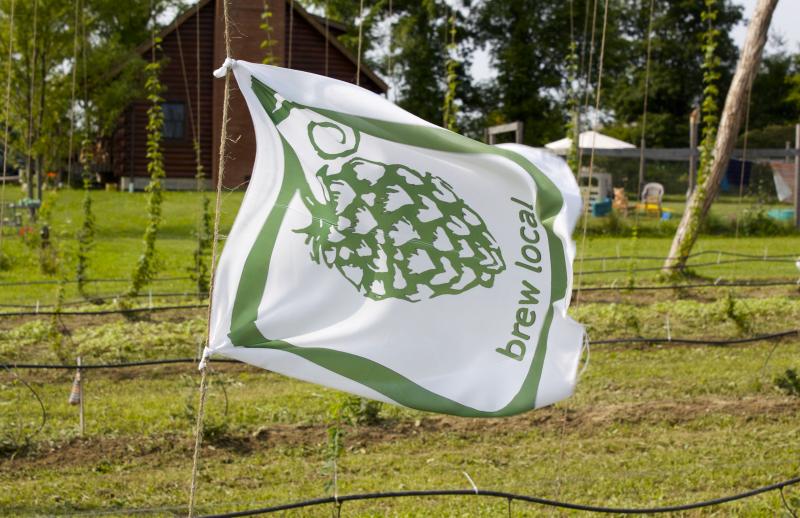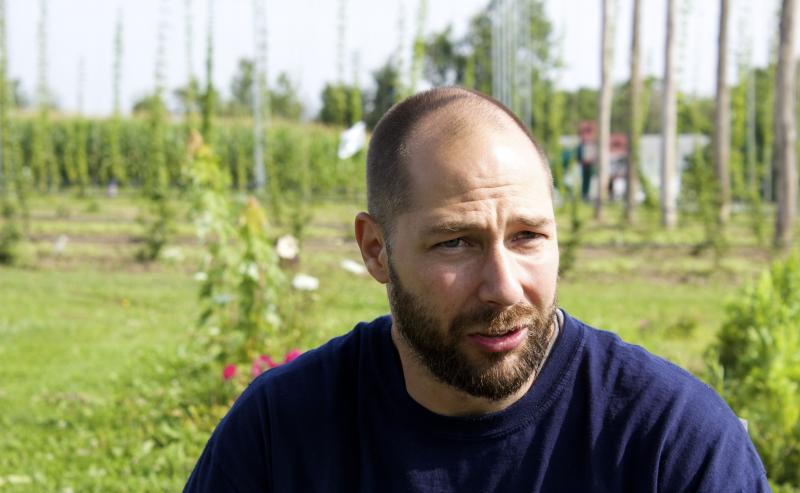 The female flowers of the hop plant have been used since the 11th Century to add that bitter, tangy flavor. The female flowers of the hop plant have been used since the 11th Century to add that bitter, tangy flavor.
The Schneider family grows them on a wind-swept hill in Aurora. By day, Ted’s a software engineer. Jessica’s an Air Force veteran now tending to toddlers.
“Ivey will be 3 very soon and Anderson just turned 1.”
She says they’d planned to grow wine grapes before finding the 16-acre property, which "was very well suited for hops. The match was clear as soon as we found it. because of the rolling hill and the high winds. This was previously called Windy Hill Farm.”
Beer aficionados
Besides, says Ted, “we both like to drink a little beer here and there.”
They went to Germany for Munich’s Octoberfest for their honeymoon.
The Schneiders haven’t sold a lot of hops yet. Ted Schneider expects it’ll take another year for the roots to sink in enough for full production.
But their hopes are as high as their towering plants.
“The craft market here really blew up, and now there’s a big demand for hops. So our local brewpubs, breweries, even the small guy, the craft brewers whojust want to brew beer for themselves, we want to give them a fresh product.”
The magic of lupulin
At Schneider's Hop Haus, leafy shoots, or bines, wind clockwise around wooden poles, climbing 20 feet into the blue sky.
Jessica Schneider reaches up to nip off a female flower, or cone.
“And inside the hop cone, ... you’ll see a yellow powder. That is the lupulin, and that is the beer magic right there -- not unlike an essential oil or the pollen of the hop plant. And this is what will fragrance your beer and add the hoppy nature.”
They’re wet, fresh hops, just what brewer Michael Malone needs at Main Street Grille and Brewing Co. in nearby Garrettsville.
“The farm in Aurora, they’re so close that I could call them right now and they could bring some out in a couple of hours.”
Fresh and fast but not cheap
 He says fresh hops make his beer taste better, but they have to be used almost as soon as they’re picked. Ted Schneider can meet that need. He says fresh hops make his beer taste better, but they have to be used almost as soon as they’re picked. Ted Schneider can meet that need.
Besides, Malone prefers dealing with local suppliers.
“We know we’re going to get a quality product from them. I can actually go up to their farm and check them out and see what they’re doing.”
One of the nation’s biggest hops distributors is L.D. Carlson in Portage County, but it doesn’t buy any hops from Ohio farmers.
It gets them from the Pacific Northwest, mostly from Washington State’s Yakima Valley where almost 80 percent of the U.S. hop crop is grown.
Sales and marketing manager Brian Wright says it’s a dependable source -- “not only a more consistent product, but probably one that is also priced more competitively.”
The Schneiders charge $10 to $12 per pound for their hops. That’s as much as 75 percent higher than companies like L.D. Carlson. But unlike big distributors, the Schneider’s sell organic and fresh hops.
That makes them more expensive to grow. As organic farmers they have a tougher time coping with plant disease and pests.
“You have your downy mildew, your powdery mildew, spider mites, leaf hoppers, Japanese beetles.”
Advice to farmers: hop to it
One of the Schneider’s advisers, Ohio State University horticulturalist Brad Bergefurd, conducted a hops workshop earlier this year at a conference for Ohio farmers.
Yes, he says, they do face strong competition from the hop yards out West.
 But they have a chance. But they have a chance.
“Over the past 10 years there’s been some shortages of hops, and there’s a real shortage of some varieties. Some of these microbrewers are having to book and pay for their hops two and three years out from some of these West Coast suppliers -- all the more reason the brewers would love to have some Ohio-grown hops right in their own backyard.”
With a federal grant, Bergefurd’s been experimenting at OSU South in Piketon and at another hop yard established by the Ohio Agricultural Research and Development Center in Wooster.
Collaboration more than competition
He consults with 20 hops farmers across the state, and the Schneiders know many of them.
“They’re not really competitors,” says Ted. “They’re friends. They’re farmers. We’re all in it together trying to bring hops back. And there are more breweries than hops suppliers at this point. So those of us on the ground floor, we certainly can all share in the market.”
Ohio State estimates $4 million leaves the state annually for hops purchases, and the Schneiders want part of it.
Tilling with toddlers
Their first dollar is tacked on one of their hop poles and their hopes are pinned on the harvest. But for now, like most Ohio hops farmers, they’re keeping their day jobs.
“Some call us crazy. Some call us hard workers. But we’re all trying to do the same thing. We all like to drink beer. We all like to see the local beer survive. Several of us have families with young children who bring our  toddlers to the fields daily. That’s what we’re up against, crying babies.” toddlers to the fields daily. That’s what we’re up against, crying babies.”
And that’s this week’s Quick Bite.
Next week we look at a new approach for healthy school lunches.
|